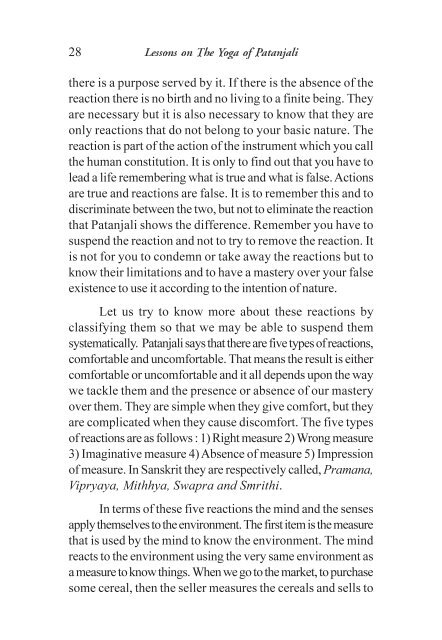The Yoga of Patanjali
By Master E.K.
By Master E.K.
You also want an ePaper? Increase the reach of your titles
YUMPU automatically turns print PDFs into web optimized ePapers that Google loves.
28 Lessons on <strong>The</strong> <strong>Yoga</strong> <strong>of</strong> <strong>Patanjali</strong>there is a purpose served by it. If there is the absence <strong>of</strong> thereaction there is no birth and no living to a finite being. <strong>The</strong>yare necessary but it is also necessary to know that they areonly reactions that do not belong to your basic nature. <strong>The</strong>reaction is part <strong>of</strong> the action <strong>of</strong> the instrument which you callthe human constitution. It is only to find out that you have tolead a life remembering what is true and what is false. Actionsare true and reactions are false. It is to remember this and todiscriminate between the two, but not to eliminate the reactionthat <strong>Patanjali</strong> shows the difference. Remember you have tosuspend the reaction and not to try to remove the reaction. Itis not for you to condemn or take away the reactions but toknow their limitations and to have a mastery over your falseexistence to use it according to the intention <strong>of</strong> nature.Let us try to know more about these reactions byclassifying them so that we may be able to suspend themsystematically. <strong>Patanjali</strong> says that there are five types <strong>of</strong> reactions,comfortable and uncomfortable. That means the result is eithercomfortable or uncomfortable and it all depends upon the waywe tackle them and the presence or absence <strong>of</strong> our masteryover them. <strong>The</strong>y are simple when they give comfort, but theyare complicated when they cause discomfort. <strong>The</strong> five types<strong>of</strong> reactions are as follows : 1) Right measure 2) Wrong measure3) Imaginative measure 4) Absence <strong>of</strong> measure 5) Impression<strong>of</strong> measure. In Sanskrit they are respectively called, Pramana,Vipryaya, Mithhya, Swapra and Smrithi.In terms <strong>of</strong> these five reactions the mind and the sensesapply themselves to the environment. <strong>The</strong> first item is the measurethat is used by the mind to know the environment. <strong>The</strong> mindreacts to the environment using the very same environment asa measure to know things. When we go to the market, to purchasesome cereal, then the seller measures the cereals and sells to






